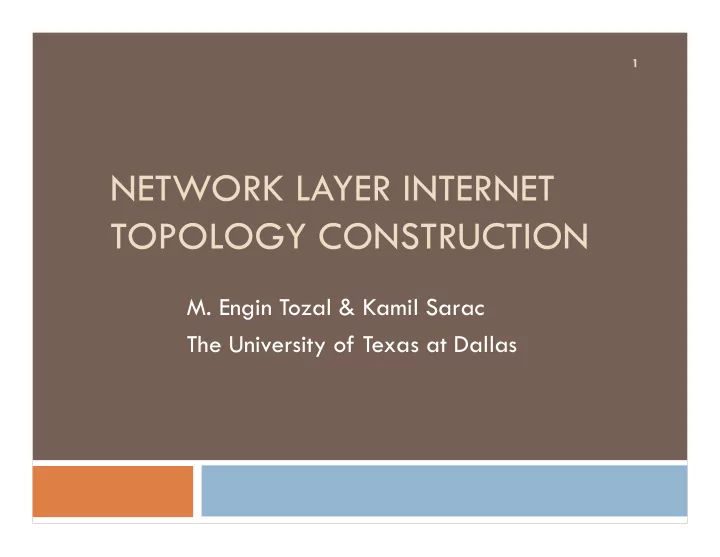

1 NETWORK LAYER INTERNET TOPOLOGY CONSTRUCTION M. Engin Tozal & Kamil Sarac The University of Texas at Dallas
AGENDA 2 Internet Topology and its Representation Existing Topology Representations Subnet Level Topologies Subnet Inference with XNET Current Research
Internet Topology 3 Internet Topology Maps Represented as a graph G(V,E) such that V is the set of objects and E is the set of links between objects in V. Vertices: Autonomous Systems (ASes) Routers Router Triangles Interfaces Subnetworks (Subnets)
Internet Topology 4 Inter-Connections Policy-based connections Subnets Routers Do we really have a distinction between components in the Internet and their inter-connections? Or is it a matter of representation and interest?
AGENDA 5 Internet Topology and its Representation Existing Topology Representations Subnet Level Topologies Subnet Inference with XNET Current Research
Existing Internet Topologies 6 AS Level Interface Level Router Level
Existing Internet Topologies AS Level 7 AS2 AS4 AS1 AS3 A Sample Section of the Internet Topology at the Network Layer
Existing Internet Topologies AS Level 8 AS2 AS1 AS4 AS3 AS Level Representation
Existing Internet Topologies Interface Level 9 Y AS2 AS4 X AS1 AS3 Z A Sample Section of the Internet Topology at the Network Layer
Existing Internet Topologies Interface Level 10 Y X Z Interface Level Representation
Existing Internet Topologies Router Level 11 R2 R3 R1 S1 S2 S3 S5 S4 R6 R4 R5 R8 R7 A Sample Section of the Internet Topology at the Network Layer
Existing Internet Topologies Router Level 12 R2 R3 R1 R6 R4 R5 R8 R7 Router Level Representation
AGENDA 13 Internet Topology and its Representation Existing Topology Representations Subnet Level Topologies Subnet Inference with XNET Current Research
Subnet Level Topologies 14 R2 R3 R1 S1 S2 S3 S5 S4 R6 R4 R5 R8 R7 A Sample Section of the Internet Topology at the Network Layer
Subnet Level Topologies 15 S1 S2 S3 S5 S4
Subnet Level Topologies 16 /30 /31 S1 S2 S3 /31 S5 S4 /29 /29 Subnet Level Representation
Subnet Level Topologies 17 Subnet Level Internet Topologies A subnet S is defined by the set of interfaces that it accommodates A vertex in the graph is a subnet A link between two subnets represents the router that directly connects two subnets to each other TraceNET is a tool for building subnet level Internet topologies XNET is another tool for inferring individual subnets
Utility of Subnet Level Topologies 18 Building node-and-link disjoint end-to-end paths for overlay network design
Utility of Subnet Level Topologies 19 Studying Subnet Level Topology Characteristics Degree Distribution IP address space Utilization Betweenness Assortativity Clustering Coefficient and so on…
AGENDA 20 Internet Topology and its Representation Existing Topology Representations Subnet Level Topologies Subnet Inference with XNET Current Research
Subnet Inference with XNET 21 ExploreNET (XNET) Given an IP address t, XNET builds the subnet S hosting t Collects all alive IP addresses accommodated by S Labels S by its observed subnet mask TraceNET Given a destination address d Returns a list of subnets appearing between the source and the destination address d
Subnet Inference with XNET 22 XNET vs TraceNET Both are based on the same principles TraceNET has more data to draw inference (subnets and IP addresses appearing in previous hops) XNET can be utilized in uniform random subnet sampling TraceNET sampling possesses source dependency bias
Subnet Inference with XNET 23 A S
Subnet Inference with XNET 24 Scope Delimitation Test Far Fringe Interface Detection Test Ingress Fringe Interface Detection Test Close Fringe Interface Detection Test
Subnet Inference with XNET 25 Close-fringe Far-fringe interfaces interfaces A S Ingress-fringe interfaces Fringe Interface Detection
AGENDA 26 Internet Topology and its Representation Existing Topology Representations Subnet Level Topologies Subnet Inference with XNET Current Research
Current Research 27 Network Level Internet Topology Maps A mathematical framework for sampling subnets using XNET Developing a network generation model based on subnets
Internet Topology Representations 28 Example Internet Topology
Internet Topology Representations 29 Router Level Representation
Internet Topology Representations 30 Subnet Level Representation
Internet Topology Representations 31 Network Level Representation
Discussion 32 Questions & Comments
Evaluations 33 Characteristics of subnets in six geographically disperse Tier-2 ISP networks PCCW Global (ISP-1) nLayer (ISP-2) France Telecom (ISP-3) Telecom Italia Sparkle (ISP-4) Interroute (ISP-5) MZIMA (ISP-6)
Evaluations 34
Evaluations 35
Evaluations 36 Power Law in Prefix Length Distribution
Evaluations 37 Power Law in Prefix Length Distribution
Subnet Inference with XNET 38
Recommend
More recommend